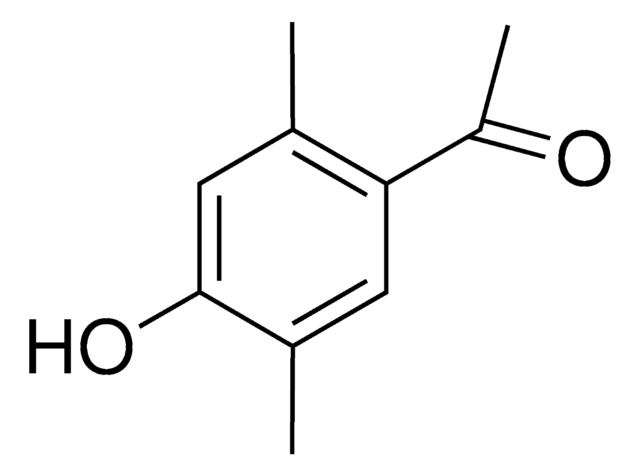405655
2-Hydroxy-2-methylpropiophenone
97%
Synonyme(s) :
1-Hydroxy-1-methylethyl phenyl ketone, 1-Phenyl-2-methyl-2-hydroxypropanone, 2-Hydroxy-2-methyl-1-phenyl-1-propanone, 2-Methyl-3-phenyl-3-oxopropan-2-ol
About This Item
Produits recommandés
Pureté
97%
Forme
liquid
Indice de réfraction
n20/D 1.533 (lit.)
Point d'ébullition
102-103 °C/4 mmHg (lit.)
Densité
1.077 g/mL at 25 °C (lit.)
Chaîne SMILES
CC(C)(O)C(=O)c1ccccc1
InChI
1S/C10H12O2/c1-10(2,12)9(11)8-6-4-3-5-7-8/h3-7,12H,1-2H3
Clé InChI
XMLYCEVDHLAQEL-UHFFFAOYSA-N
Vous recherchez des produits similaires ? Visite Guide de comparaison des produits
Description générale
Application
- Photochemical Thiol-Ene “Click” Chemistry: The study utilized 2-hydroxy-2-methylpropiophenone for the synthesis of highly functional polyols by photochemical thiol-ene “click” chemistry (M Ionescu, A Garcia-Comer, T Spidel, 2023).
- Development of Water-Soluble Type I Photoinitiators: This study focused on the development of new water-soluble type I photoinitiators for hydrogel synthesis using 2-hydroxy-2-methylpropiophenone, enhancing the understanding of photopolymerization processes (B Aubry, F Dumur, M Lansalot, E Bourgeat-Lami, 2022).
Mention d'avertissement
Warning
Mentions de danger
Conseils de prudence
Classification des risques
Acute Tox. 4 Oral - Aquatic Chronic 3
Code de la classe de stockage
10 - Combustible liquids
Classe de danger pour l'eau (WGK)
WGK 1
Point d'éclair (°F)
251.6 °F - closed cup
Point d'éclair (°C)
122 °C - closed cup
Équipement de protection individuelle
Eyeshields, Faceshields, Gloves, type ABEK (EN14387) respirator filter
Certificats d'analyse (COA)
Recherchez un Certificats d'analyse (COA) en saisissant le numéro de lot du produit. Les numéros de lot figurent sur l'étiquette du produit après les mots "Lot" ou "Batch".
Déjà en possession de ce produit ?
Retrouvez la documentation relative aux produits que vous avez récemment achetés dans la Bibliothèque de documents.
Les clients ont également consulté
Notre équipe de scientifiques dispose d'une expérience dans tous les secteurs de la recherche, notamment en sciences de la vie, science des matériaux, synthèse chimique, chromatographie, analyse et dans de nombreux autres domaines..
Contacter notre Service technique









![3-[(2-hydroxy-1-methyl-2-phenylethyl)(methyl)amino]-1-phenyl-1-propanone hydrochloride AldrichCPR](/deepweb/assets/sigmaaldrich/product/structures/151/473/3cebe599-6799-4231-860a-ea27fca60198/640/3cebe599-6799-4231-860a-ea27fca60198.png)





